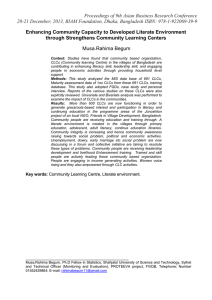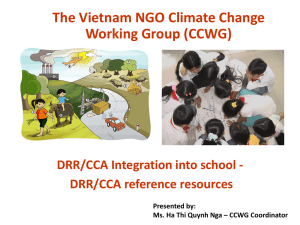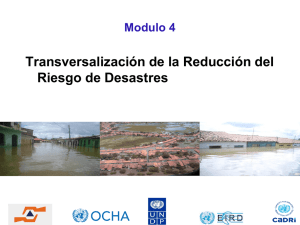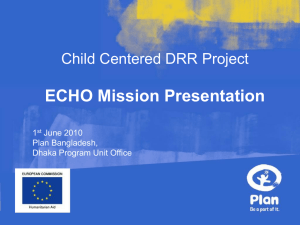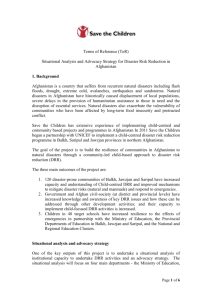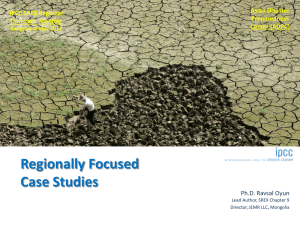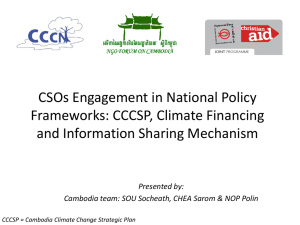Presentation DIPECHO 5 CU
advertisement
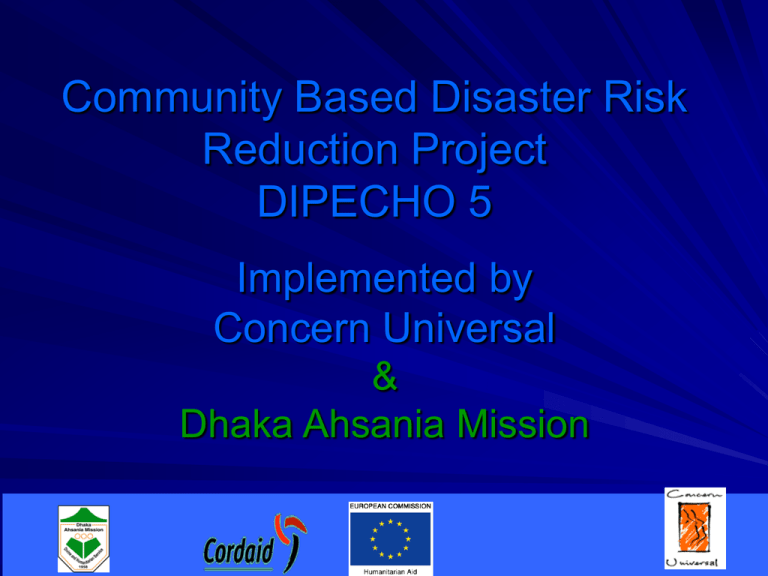
Community Based Disaster Risk Reduction Project DIPECHO 5 Implemented by Concern Universal & Dhaka Ahsania Mission Principal Objective: Sustainable decrease of the negative impact of natural disasters in the targeted Districts Specific Objective : Communities, Partners NGOs, local NGOs and International Organisations are practising standard CBDRR model against multiple natural hazards Expected Results The capacity of communities and local institutions to operate as conduits for DRR at local level is strengthened Productive linkages between targeted CLCs/Gonokendros, CBOs, relevant government DRR mechanisms, schools and other service providers are established at local level CBDRR process and materials are shared with and replicated by GOBs and NGOs Effective advocacy and information-sharing mechanisms amongst DRR practitioners are in place Where we work - 1 The project primarily targets people who live in cyclone prone areas: District Patuakhali Barguna Total Upazila Mirzagonj Pathorghata # of Unions 07 08 15 Where we work - 2 The project also includes a capacitybuilding/follow-up component that will target CU’s 6 strategic partners in India and Bangladesh Finally, the project includes a broad-based mainstreaming component though CLCs or Gonokendros in non targeted yet disaster-prone areas of Bangladesh, covering over 1500 CLCs in 7 regions of Bangladesh Project Coverage DIRECT BENEFICIARIES UP 15 15*14=210 CLCs in intervention areas 90 90*100=9000 Schools 30 30*7 SMC members+ 30*4 teachers + 30* 25 students = 1080 NGO partners 6 6 CLCs in non targeted areas 1186 1186*1 teachers=1186 Total 11482 CATCHMENT POPULATION CLCs in intervention areas 90 90*100*5= 45000 Schools 30 30*500= 15000 NGO partners beneficiaries 6 1 Million CLC in non targeted areas 1186 1186*50 = 55300 Total 1,175,300 The CBDRR process: A coordinated and vulnerability-sensitive bottomup approach which serves as the basis for replication Adaptation / Approval /Replication Advocacy / Network Documentation / Sharing Facilitate community action Awareness and skills development Planning and strategy development Community Risk Assessment Community consultation Results and activities - 1 RESULT 1: the capacity of communities and local institutions to operate as conduits for DP and DR at local level is strengthened Activity 1: Support community to undertake vulnerability assessment, understand the threat of climate change and identify their course of action Activity 2: Conduct DRR training for CLCs management committees, teachers, trainers, volunteers, radio spot managers and for project staff Activity 3: Promote mass awareness on DRR through communitybased training, cultural events and media campaigns Activity 4: Support local authorities to incorporate DP and mitigation into their official operational documents Activity 5: Train teachers, SMC ,members and student brigades on DRR and oversee the sedimentation of the information Activity 6: Build capacity of community-based action groups on early warning, rescue and response Activity 7: Support community-initiated mitigation activities Results and activities - 2 RESULT 2: Productive linkages between the targeted CLCs, relevant local government DRR mechanisms, local NGOs and service providers are in place Activity 1: Support and strengthen DRR coordination mechanisms amongst all targeted stakeholders at UP level Activity 2: Support and strengthen DRR coordination mechanisms amongst all targeted stakeholders at district and Upazila levels Results and activities - 3 RESULT 3: CBDRR process and resource materials are shared, standardised and replicated Activity 1: Develop standard Training and IEC material Activity 2: Channel Training and IEC material for interested organisations Activity 3: Process documentation and channeling of CBDRR project Activity 4: Support and follow-up to partners for DRR mainstreaming Results and activities - 4 RESULT 4: Effective advocacy and sharing mechanisms among DRR stakeholders are in place Activity 1: Identify priority areas for DRR-related advocacy Activity 2: Facilitate lessons learnt and best practices sharing with key stakeholders Activity 3: Participate in DIPECHO partners’ joint initiatives Activity 4: Support and participate in advocacy campaigns Project Organogram Country Director Project Manager PO Implementation and Documentation Head of the DRR Unit Project Training and Communication Dhaka Ahsania Mission Implementation strategy - 1 Partnerships – Partnerships for implementation: CU and DAM, CU and HI, CU and CPP – Partnership for mainstreaming: CU and 6 strategic partners – Partnership for improved coordination and advocacy: CU and CDMP, CU and DIPECHO partners Implementation strategy - 2 Community empowerment and sustainability – Working through CLCs/Gonokendro and putting Gonokendro at the centre of community-based DRR activities Implementation strategy - 3 Standardization and Modeling – IEC material – Training material – Process documentation Implementation strategy - 4 Institutional linkage and advocacy CDMP / CPP Ministry of Food and DM/ DMB District/ Upazila DMC CLCs/CBOs/UP/Schools GOB service providers NGOs DIPECHO partners / Handicap International Implementation strategy - 5 Replication and mainstreaming – Follow-up and support to strategic partners activities – Incorporation of DRR in the range of services offered by 1186 CLCs in 60 Upazilas Inclusion of cross-cutting issues – Child and woman empowerment – Disability – Climate change THANK YOU !
